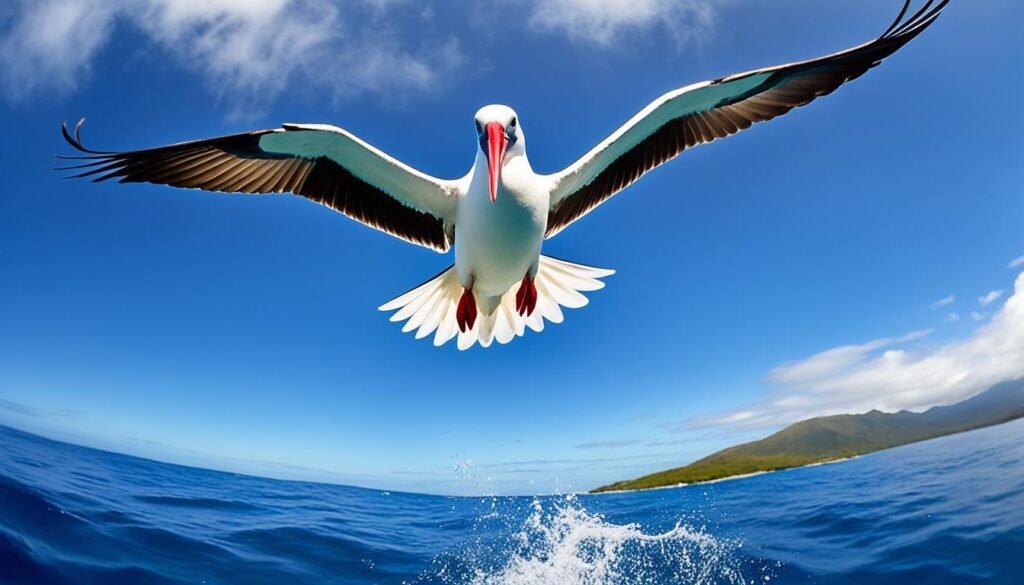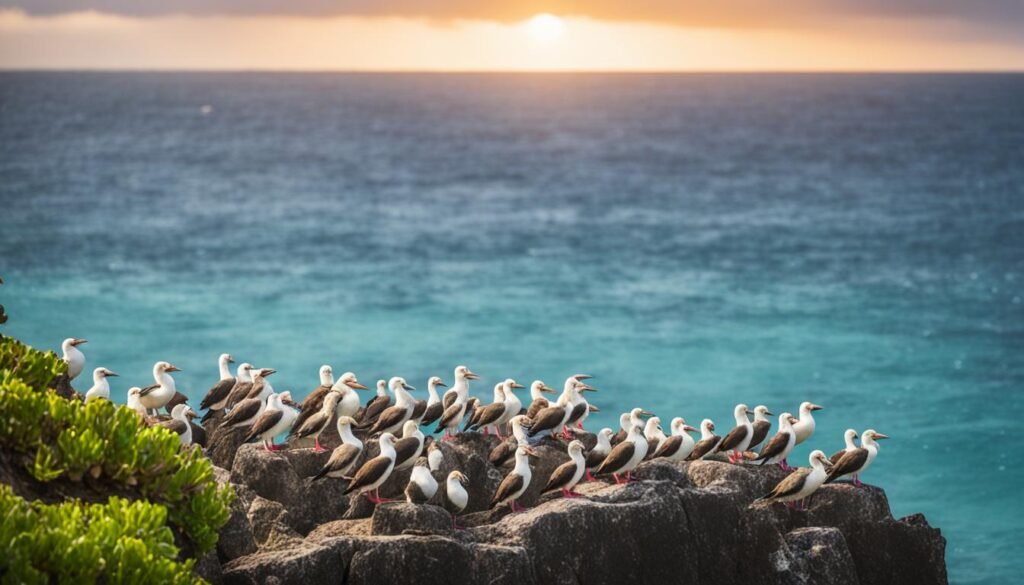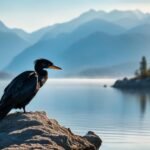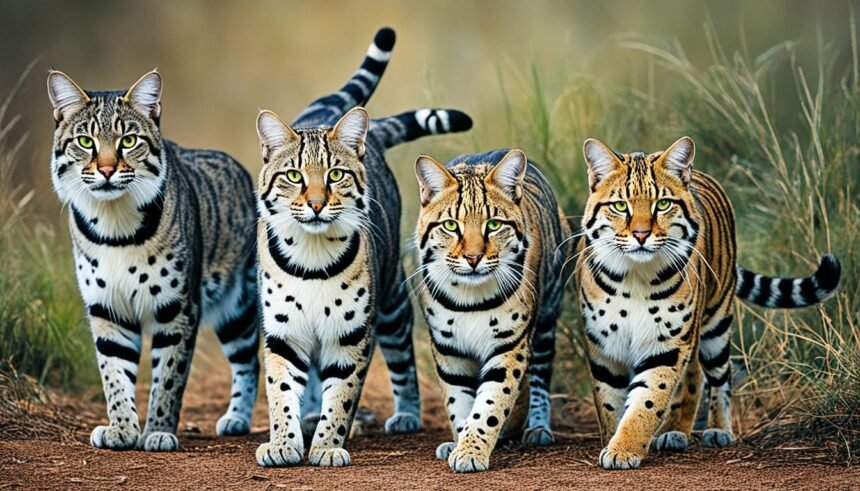In the huge, quiet ocean, red footed boobies stand out with their bright colors. These seabirds are fascinating to bird enthusiasts because they are skilled in flying and diving. They catch their food by diving into the water from the air. These birds are amazing to watch and learn about in ornithology.
Red footed boobies live in warm seas all over the world. From the Pacific’s coral islands to the Caribbean’s sunny shores. They are similar to gannets but have their own behaviors and traits. Places like the Galapagos Islands offer great chances to see them in the wild.
Even though they’re not rare, seeing red footed boobies is hard because they nest on remote islands. To see these booby species, one must venture out. Observing their courtship dances and the way they care for their chicks teaches us a lot about seabird life and how to protect them.
Understanding the Red Footed Booby: Physical Attributes
The Red-footed Booby is a medium-sized seabird known for its elegance. Its streamlined form helps it dive and fly over wide marine areas. This bird’s unique body structure lets it thrive in the ocean, showing how evolution shapes life.
Size and Shape Adaptations for Survival
The Red-footed Booby is made for agile flying. It has a wingspan of 3 to 5 feet and a wedge-shaped tail. These features allow it to move precisely in air and water.
Its strong beak is great for hunting, showing its role in the ocean ecosystem. Its webbed feet help in swimming and resting, saving energy for foraging.
Plumage Variations Across Different Morphs
The Red-footed Booby displays a variety of colors. From white with red feet and blue beak to brown morphs. This variation is nature’s artwork at its best.
The white-tailed brown and black-tailed white morphs add to the diversity. Their colors aid in hiding and in social behaviors like mating within seabird communities.
Distinctive Red Feet: A Signature Trait
The Red-footed Booby is famous for its red feet. These feet are more than just for show. They signal breeding status and glow brightly during courtship.
The male’s courtship dance is beautiful. He points his beak up in a unique display of attraction. This behavior is captivating to observe.
Research, like the studies by Weimerskirch et al. (2006) and Lormée et al. (2005), explores their fascinating world. It discusses how differences affect survival and mating. The studies highlight the bird’s ecological and reproductive strategies.
- Reversed sexual dimorphism is linked to variations in foraging methods, potentially attributed to the robust beak of males and the agile flying needs of females.
- Geographical variation in foraging behavior highlights an impressive adaptability, allowing Red-footed Boobies to exploit resources effectively across their range.
- The phenomenon of individual foraging site fidelity suggests a remarkable capacity for these seabirds to remember and return to fruitful foraging zones over time.
- Age and reproductive status not only influence foraging site fidelity but also shape the decisions made during their extensive foraging trips throughout the marine habitat.
The Red-footed Booby’s attributes show it is well-suited to its environment. Its evolution is evident from its flying and diving abilities to the color and role of its feet.
Behavioral Traits of Red Footed Boobies

Red Footed Boobies are known for their amazing flying and diving skills. These marine birds are a symbol of skill in the air and sea. They glide and dive smoothly to capture fish and squid. This is how they survive in the tough marine world.
The Red Footed Booby is a social bird that loves living in large colonies. They have complex mating behaviors and courtship rituals. These include dances, bill fencing, and preening each other. These actions are important for their reproduction and the survival of their colony.
At night, these birds become nocturnal hunters. They use the darkness to find food, showing a different side of their nature. This shows how adaptable they are in finding food.
Studies, like those by Frederiksen and others, show the impact of climate change on these birds. Extreme weather affects their feeding, breeding, and numbers. These insights help direct our conservation efforts to protect them. The work of Ballance, Weimerskirch, and Beadell highlights their flying skills and the need for conservation.
-
Wiley and Wunderle’s research shows how hurricanes affect Caribbean birds.
-
The IPCC reports on how changing climates affect migratory seabirds.
-
Mei and others link ocean conditions with stronger tropical storms, which affects seabirds.
-
Streby’s work gives us information on how birds avoid storms.
-
Weimerskirch and others show how frigate birds use weather patterns. This information is key to understanding bird life.
With better knowledge, we can improve our conservation efforts. We aim to protect Red Footed Boobies from future dangers.
The Red-Footed Boobies’ Habitat: A Global Perspective

Marine birds such as the Red-footed Booby thrive in tropical zones. These zones span the Atlantic, Pacific, and Indian Oceans. They provide perfect breeding and feeding grounds.
Places like the Hawaiian and Galapagos Islands are key homes for them. You can learn more about their nesting spots on Bird Island here.
Since 2003, Red-footed Boobies have joined frigatebirds in roosting. They often rest in trees and shrubs. In 2015, 66 were spotted, but by 2021, this number soared to 980.
They also use the Casuarinas’ dense foliage for nesting sites.
Their nesting habits are good for the lands they live on. They help with nutrient cycling. Counting during the day in 2019, over 100 were seen.
Throughout their lives, they face challenges on land and at sea. But they manage to help the marine ecosystem.
Breeding sites, especially in the Seychelles, are growing. This shows thriving colonies. The Amirantes archipelago shows their northern movement.
Back in the 1990s, Red-footed Boobies mostly nested in places like Aldabra. Today, they have spread out due to adaptation and past threats.
Tropical and Subtropical Regions: A Preferred Environment
Since 2003, Red-footed Boobies have expanded their territories. They now roost alongside frigatebirds. Numbers grew from 66 in 2015 to 980 in 2021.
They are drawn to the Atlantic, Pacific, and Indian Oceans. The Hawaiian Islands and Galapagos Islands offer great climates and food.
Nesting Habits: Trees, Shrubs, and Ground
Their nesting habits stand out. They prefer trees and shrubs for their young. This is unlike many seabirds.
This choice boosts nutrient cycling below them. It shows their big role in terrestrial ecosystems.
Adaptation to Marine Life
Adapting is key for Red-footed Boobies. Their survival strategies show their skill in vast pelagic areas. With great flying skills, they often pick unusual nesting sites like rock cliffs.
This versatility showcases their skill and adaptability in different places.
Red Footed Boobies: A Journey in Ornithology

Exploring seabird knowledge, experts find red footed boobies key to learning about global seabird trends. These birds weigh around 837 grams and have traits that make them stand out in bird studies.
Things like habitat destruction and overfishing disrupt their life patterns. These effects even impact the 44 to 46 day egg incubation. This makes it harder to plan how to protect these birds. Also, it takes about five months for young boobies to start flying well. This shows their growth is slow but detailed.
Studying how these birds mate and stay together reveals much for conservation efforts. Many pairs stay bonded across seasons, sharing deep connections. This information helps guide protection steps and keep their species going. Watching them in the Caribbean is key to developing strong conservation strategies.
Reviewing breeding data shows we need ongoing education and action to help these birds. Focusing on the bird population in areas helps make smarter choices. This keeps not only the boobies but also their ecosystem balanced.
- Average adult weight: 837 grams
- Egg incubation period: 44–46 days
- Time to extensive flights for young: ~5 months
- Longevity of breeding pairs: Multiple seasons
This study of birds teaches us much and asks us to think about our part in nature. The fate of these boobies and our world depends on what we do now. We need thorough monitoring and responsibility globally.
Conclusion
The link between adaptive behaviors and the environments of red-footed boobies shows how complex bird life is. Researchers discover how these birds perfectly move through sea and land. For example, they spend most of their time flying, using the wind to go fast and glide while hunting.
They dive into the water about 4.5 times every hour. They can go as deep as 2.4 meters. Thanks to tiny tracking devices, we know a lot about how they fly and dive.
Conserving red-footed boobies is crucial for keeping our planet’s biodiversity. Bird watchers and nature fans love learning about these birds. Protecting them helps us enjoy their amazing behaviors, like flying high to avoid predators and their unique feather colors.
Research on feather colors teaches us about their genetics. It shows us that different looking birds live together, even on islands with different bird numbers.
Red-footed boobies are examples of nature’s resilience and beauty. Conservation work tries to save these birds and keep our ecosystems balanced. Everyone who loves birds and biodiversity sees these birds as important. They inspire us to support conservation and enjoy the beauty of nature.
FAQ
What exactly are red-footed boobies?
Red-footed boobies are a type of seabird in the Sulidae family. This family also has gannets and other booby birds. These birds are known for their unique behaviors and looks, which makes them interesting for bird studies.
How have red-footed boobies adapted for their marine lifestyle?
These birds have sleek bodies, long wings, and a wedge-shaped tail. This makes flying and diving easy for them. They have strong beaks and webbed feet to catch fish and squid.
Are there different types of red-footed booby morphs?
Yes, red-footed boobies come in different color patterns. These include mostly white birds, brown ones, and some with mixed colors. These colors help in recognizing each bird and in their mating behaviors.
What is the significance of the red feet in red-footed boobies?
The bright red feet of these boobies stand out, especially in courting. Their feet get even brighter in breeding season. They use their red feet in rituals like ‘sky-pointing’ to attract a mate.
Where can red-footed boobies be found?
These birds live in tropical and subtropical waters worldwide. They form large colonies on islands like Hawaii and the Galapagos.
How do red-footed boobies nest and what are their nesting habits?
Red-footed boobies are unique because they often nest in trees or shrubs. On the ground, they prefer soft or rocky areas. They build nests with twigs, sticks, and leaves.
What are the behavioral traits of red-footed boobies?
They are known for flying long distances and diving well to catch food. They’re social in large groups and can hunt at night. This is uncommon among seabirds.
Why is ornithology important in the study of red-footed boobies?
Studying them helps us understand bird population trends and how humans and nature affect them. This knowledge is key for protecting birds and keeping the ocean’s ecosystems balanced.













